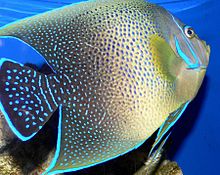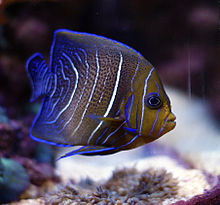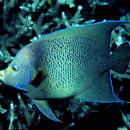Diagnostic Description
(
Inglês
)
fornecido por Fishbase
Description: Juveniles of this species are bluish black with concentric white semi-circles. Adults brownish on anterior and posterior third of the body; middle portion greenish or yellowish; numerous blue spots on the sides; posterior part of dorsal and anal fins prolonged as a filament, the tips bright yellow. Transformation to the adult color pattern occurs over the size range of about 8 - 16 cm (Ref. 1602). Body depth 1.6-1.9 in SL. Scales longitudinal series 65-70 (Ref. 90102).
- licença
- cc-by-nc
- direitos autorais
- FishBase
Diseases and Parasites
(
Inglês
)
fornecido por Fishbase
Hole-in-the-Head Disease. Parasitic infestations (protozoa, worms, etc.)
- licença
- cc-by-nc
- direitos autorais
- FishBase
Diseases and Parasites
(
Inglês
)
fornecido por Fishbase
Bacterial Infections (general). Bacterial diseases
- licença
- cc-by-nc
- direitos autorais
- FishBase
Morphology
(
Inglês
)
fornecido por Fishbase
Dorsal spines (total): 13; Dorsal soft rays (total): 20 - 23; Analspines: 3; Analsoft rays: 18 - 22
- licença
- cc-by-nc
- direitos autorais
- FishBase
Trophic Strategy
(
Inglês
)
fornecido por Fishbase
Occur inshore(Ref. 75154). Juveniles inhabit shallow protected areas, while adults prefer coastal reefs with heavy coral growth providing ample hiding places. Generally solitary. Feed on sponges, tunicates, and algae (Ref. 30573). The young are excellent aquarium fish and suitable for a community tank.
- licença
- cc-by-nc
- direitos autorais
- FishBase
Biology
(
Inglês
)
fornecido por Fishbase
Juveniles inhabit shallow protected areas, while adults prefer coastal reefs with heavy coral growth providing ample hiding places. Generally solitary or in pairs. Feeds on sponges, tunicates, and algae (Ref. 30573). The young are excellent aquarium fish and suitable for a community tank.
- licença
- cc-by-nc
- direitos autorais
- FishBase
- Recorder
- Estelita Emily Capuli
Importance
(
Inglês
)
fornecido por Fishbase
fisheries: minor commercial; aquarium: commercial; price category: high; price reliability: very questionable: based on ex-vessel price for species in this family
- licença
- cc-by-nc
- direitos autorais
- FishBase
- Recorder
- Estelita Emily Capuli
分布
(
Inglês
)
fornecido por The Fish Database of Taiwan
分布於印度-西太平洋區,自紅海及東非洲到斐濟,北到日本南部,南至澳洲及羅得豪島。台灣各地岩礁及珊湖礁海域皆可見其蹤跡。
- licença
- cc-by-nc
- direitos autorais
- 臺灣魚類資料庫
利用
(
Inglês
)
fornecido por The Fish Database of Taiwan
一般以潛水方式捕捉。為觀賞魚類,無食用經濟價值。可存活於水族箱內。
- licença
- cc-by-nc
- direitos autorais
- 臺灣魚類資料庫
描述
(
Inglês
)
fornecido por The Fish Database of Taiwan
體略高而呈卵圓形;背部輪廓略突出,頭背於眼上方平直。吻鈍而小。眶前骨寬突,不游離;前鰓蓋骨後緣及下緣具弱鋸齒,具一長棘;鰓蓋骨後緣平滑。體被小型圓鱗,腹鰭基底具腋鱗。背鰭硬棘XIII,軟條20-22;臀鰭硬棘III,軟條20-21;背鰭與臀鰭軟條部後端尖形,略呈絲狀延長;腹鰭尖,第一軟條延長,達臀鰭起點;尾鰭鈍圓形。幼魚體一致為深藍色,體具若干白弧狀紋,隨著成長白弧紋愈多;中型魚體前後部位逐漸偏褐色,中央部位偏淡褐色,弧紋亦逐漸消失;成魚體呈黃褐色至暗褐色,體側弧形不顯,取而代之的是散佈許多暗色小點,前鰓蓋骨及鰓蓋骨後緣具藍紋,上下頜黃色,各鰭緣多少具藍緣,亦具藍色或白色小點。
- licença
- cc-by-nc
- direitos autorais
- 臺灣魚類資料庫
棲地
(
Inglês
)
fornecido por The Fish Database of Taiwan
幼魚生活於較淺水域,成魚則棲息於珊瑚繁生的水域。具有領域性,會攻擊其它同類或不同類魚。以海綿、附著生物和藻類為食。
- licença
- cc-by-nc
- direitos autorais
- 臺灣魚類資料庫
Pomacanthus semicirculatus
(
Inglês
)
fornecido por wikipedia EN
Pomacanthus semicirculatus, also known as the semicircled angelfish, Koran angelfish, blue angelfish, zebra angelfish or half-circled angelfish, is a species of ray-finned fish, a marine angelfish, in the family Pomacanthidae. It is found in the Indo-West Pacific Ocean. It occasionally makes its way into the aquarium trade.
Description

Adult
Pomacanthus semicirculatus
Pomacanthus semicirculatus, like other members of the genus Pomacanthus has adults and juveniles which are very different from each other. The adults are brownish green in colour with the scales edged in blue creating a blue speckling over the body and tail. All of the fins, apart from the plain yellow pectoral fins, have blue margins. There are long, filamentous growths from the dorsal and anal fins. [4]

Juvenile Koran angelfish in a home aquarium

Juvenile
Pomacanthus semicirculatus
The juveniles in contrast, are blue-black marked from top to bottom with narrow white stripes. At the head end the stripes are fairly straight but they become increasingly curved as they approach the base of the tail. The juveniles gradually adopt the adult colouration when they are 8 to 16 centimetres (3.1 to 6.3 in).[5]
The dorsal fin contains 13 spines and 20-23 soft rays while the anal fin contains 3 spines and 18-22 soft rays. This species attains a maximum total length of 40 centimetres (16 in).[6]
Distribution
Pomacanthus semicirculatus is found in the Indo-Pacific region. Its range extends from the eastern coast of Africa from the southern Red Sea coast of Sudan south as far as South Africa. It then occurs east across the Indian and Pacific Oceans to Fiji, Tonga and Samoa.It occurs as far north as southern Japan and south to Australia.[1] Within the Australian EEZ this species is widespread from the Houtman Abrolhos of Western Australia around the coast to as far south on the eastern coast as Sydney, juveniles extending farther south to Merimbula. It is also found at Christmas Island, the Cocos (Keeling) Islands as well as Lord Howe Island in the Tasman Sea.[7] It has also been seen sporadically off the east coast of Florida since 1999 and at Oahu, Hawaii since 2005.[5]
Habitat and biology
Pomacanthus semicirculatus is found at depths between 1 and 40 m (3 ft 3 in and 131 ft 3 in)[1] on sheltered coral reefs, where it feeds on algae, tunicates and sponges. The juveniles are very timid and difficult to approach.[5] The juveniles occur in shallow sheltered areas, while adults show a preference for coastal reefs where there is rich coral growth which give the fish plenty of places to hide. It is typically encountered in pairs or as solitary individuals.[6] The adults have been recorded from wrecks.[1]
Systematics
Pomacanthus semicirculatus was first formally described as Holacanthus semicirculatus in 1831 by the French anatomist Georges Cuvier (1769–1832) with the type locality given as Timor, Bourou, Waigeo, Indonesia, and Port Praslin, New Ireland Island, Bismarck Archipelago in Papua New Guinea.[8] Some authorities place this species in the subgenus Arusetta. The specific name semicirculatus means “semicircular”, a reference to the semicircular slender blue and white lines on the rear of the body on juveniles, which are lost on the adults.[9]
Utilisation
Pomacanthus semicirculatus is frequently encountered in the aquarium trade.[1]
References
-
^ a b c d e Pyle, R.; Myers, R.F.; Rocha, L.A.; Craig, M.T. (2010). "Pomacanthus semicirculatus". IUCN Red List of Threatened Species. 2010: e.T165851A6148505. doi:10.2305/IUCN.UK.2010-4.RLTS.T165851A6148505.en. Retrieved 20 November 2021.
-
^ Bailly, Nicolas (2010). "Pomacanthus semicirculatus (Cuvier, 1831)". WoRMS. World Register of Marine Species. Retrieved 2012-02-27.
-
^ Eschmeyer, William N.; Fricke, Ron & van der Laan, Richard (eds.). "Species in the genus Pomacanthus". Catalog of Fishes. California Academy of Sciences. Retrieved 3 March 2023.
-
^ "Pomacanthus semicirculatus". Saltcorner!. Bob Goemans. 2012. Retrieved 4 March 2021.
-
^ a b c Pomacanthus semicirculatus (Cuvier, 1831): Semicircle Angelfish USGS. Retrieved 2012-02-27.
-
^ a b Froese, Rainer; Pauly, Daniel (eds.) (2019). "Pomacanthus semicirculatus" in FishBase. December 2019 version.
-
^ Dianne J. Bray. "Pomacanthus semicirculatus". Fishes of Australia. Museums Victoria. Retrieved 4 March 2021.
-
^ Eschmeyer, William N.; Fricke, Ron & van der Laan, Richard (eds.). "Species in the genus Pomacanthus". Catalog of Fishes. California Academy of Sciences. Retrieved 4 March 2021.
-
^ Christopher Scharpf & Kenneth J. Lazara (21 July 2020). "Order ACANTHURIFORMES (part 1): Families LOBOTIDAE, POMACANTHIDAE, DREPANEIDAE and CHAETODONTIDAE". The ETYFish Project Fish Name Etymology Database. Christopher Scharpf and Kenneth J. Lazara. Retrieved 4 March 2021.

- licença
- cc-by-sa-3.0
- direitos autorais
- Wikipedia authors and editors
Pomacanthus semicirculatus: Brief Summary
(
Inglês
)
fornecido por wikipedia EN
Pomacanthus semicirculatus, also known as the semicircled angelfish, Koran angelfish, blue angelfish, zebra angelfish or half-circled angelfish, is a species of ray-finned fish, a marine angelfish, in the family Pomacanthidae. It is found in the Indo-West Pacific Ocean. It occasionally makes its way into the aquarium trade.
- licença
- cc-by-sa-3.0
- direitos autorais
- Wikipedia authors and editors
Description
(
Inglês
)
fornecido por World Register of Marine Species
Juveniles inhabits shallow protected areas, while adults prefer coastal reefs with heavy coral growth providing ample hiding places. Common in depths less than 25 m. Generally a solitary species. Apparently rare in Belau. The young are excellent aquarium fish and suitable for a community tank.
Froese, R. & D. Pauly (Editors). (2023). FishBase. World Wide Web electronic publication. version (02/2023).
- licença
- cc-by-4.0
- direitos autorais
- WoRMS Editorial Board

